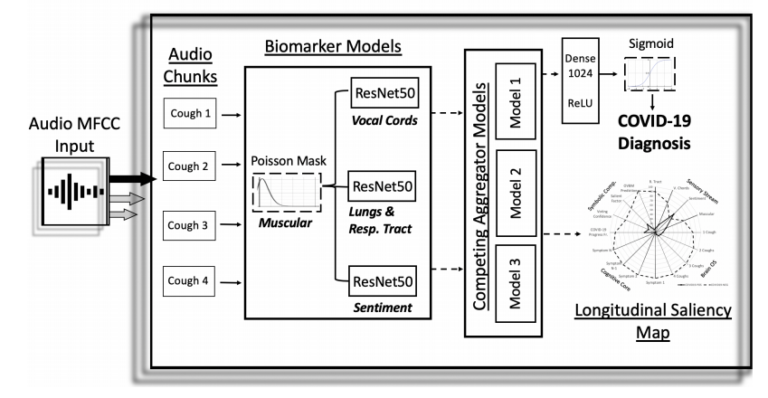How COVID-19 Can Be Positively Detected By An AI Model, a Cough and a Smartphone

As early as December 2019, AI systems were warning policy-makers about the coronavirus. As the pandemic gained a foothold and began to spread across the world, AI found a number of other applications in the fight against COVID-19: mapping cases based on social media activity; diagnosing patients based on lung scans; and identifying promising molecules for therapeutic and vaccine development. Since then, AI applications in the coronavirus pandemic have somewhat slowed – and, some argue, perhaps failed to live up to the transformative promises of AI in healthcare.
Now, MIT researchers have found a new angle: applying AI to detect COVID-19 in an asymptomatic patient.
From a cough.
Recorded by a phone.
Secret Signals
Asymptomatic transmission of COVID-19 continues, researchers believe, to be a major source of its spread. Many infected people (particularly infected young people) may not know they have COVID-19 for several days after infection, if at all – but during much of that time, they nonetheless remain infectious to those around them. In this way, the virus spreads more easily than many others, simply because it is more likely to be spread by people who are not aware that they are sick.
However, it turns out that asymptomatic carriers may not be completely asymptomatic after all.
In the before-time, the same MIT researchers had been working on AI cough models to detect signs of Alzheimers, which causes neuromuscular degradation that is associated with weaker vocal cords. Using three layered neural networks, the researchers had carefully tuned the model to control for differences in emotion, differences in vocal cord strength, and differences in respiratory health when processing coughs, arriving at an algorithm aimed at detecting the kind of degradation associated with Alzheimer’s.
“The sounds of talking and coughing are both influenced by the vocal cords and surrounding organs. This means that when you talk, part of your talking is like coughing, and vice versa,” said Brian Subirana, a research scientist in MIT’s Auto-ID Laboratory and one of the co-authors of the paper, in an interview with MIT’s Jennifer Chu. “It also means that things we easily derive from fluent speech, AI can pick up simply from coughs, including things like the person’s gender, mother tongue, or even emotional state. There’s in fact sentiment embedded in how you cough. So we thought, why don’t we try these Alzheimer’s biomarkers … for COVID.”
Listening Closely
So, earlier this year, researchers from MIT solicited tens of thousands of recorded “forced” (i.e. not naturally occurring) coughs from over 5,300 subjects – both COVID-positive and COVID-negative – in addition to data about physical symptoms and demographics. They then used that data to train a revised version of their Alzheimer’s model to distinguish between COVID-infected and COVID-uninfected coughers.
And, it turns out, the model could do just that. After training, it successfully identified 98.5% of COVID-positive coughs from new recordings, including – most impressively – 100% of asymptomatic COVID-positive coughs (the tool may actually perform better for asymptomatic coughers because a symptomatic cough may be a symptom of a non-COVID ailment, such as the flu). While the coughs sounded identical to the human ear, the AI voice model picked up on telling discrepancies. “We think this shows that the way you produce sound, changes when you have Covid, even if you’re asymptomatic,” Subirana said.
Scaling Up
Since the first data solicitation, the cough dataset has grown to hundreds of thousands of cough samples, which the researchers say constitutes the largest cough dataset available (to their knowledge). Now, the researchers are working to implement the AI model into an app, after which it will require FDA approval as a pre-screening tool. While that may be a lengthy process, the researchers are excited about the possibilities that wide-scale adoption of their model could enable.
“AI techniques can produce a free, non-invasive, real-time, any-time, instantly distributable, large-scale COVID-19 asymptomatic screening tool to augment current approaches in containing the spread of COVID-19,” the paper concluded. “Practical use cases could be for daily screening of students, workers, and public as schools, jobs, and transport reopen, or for pool testing to quickly alert of outbreaks in groups.”
“The effective implementation of this group diagnostic tool could diminish the spread of the pandemic if everyone uses it before going to a classroom, a factory, or a restaurant,” Subirana added.
This article first appeared on sister website Datanami.











